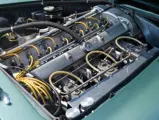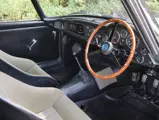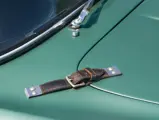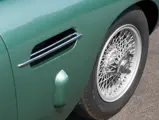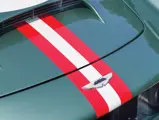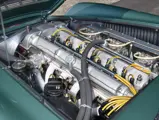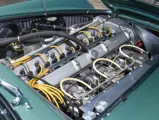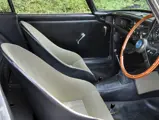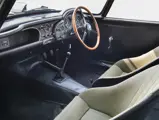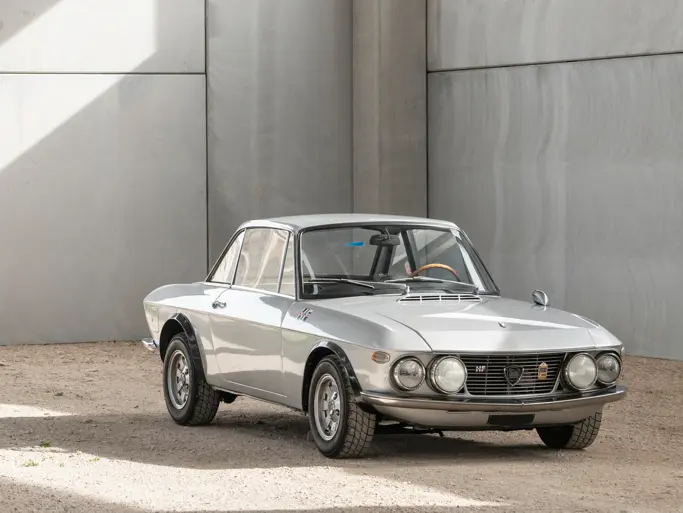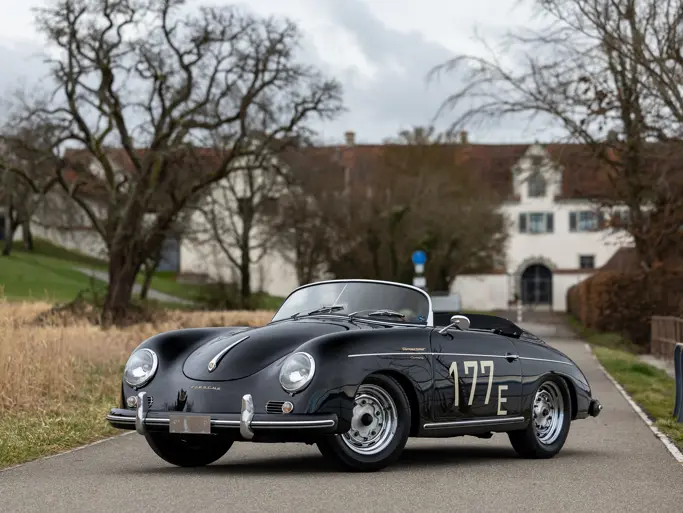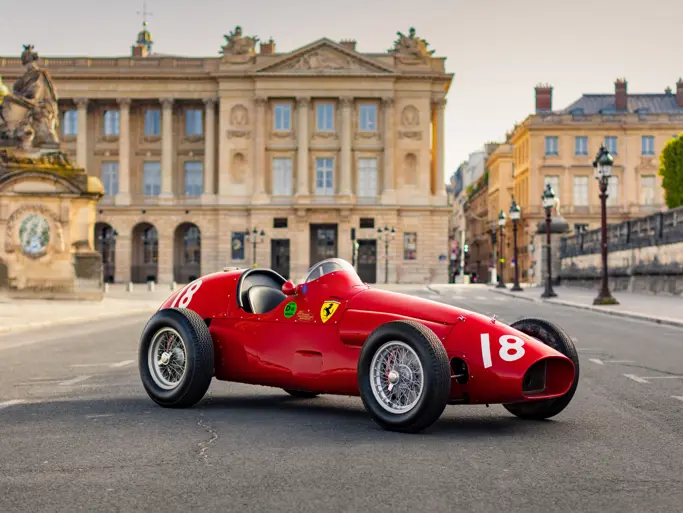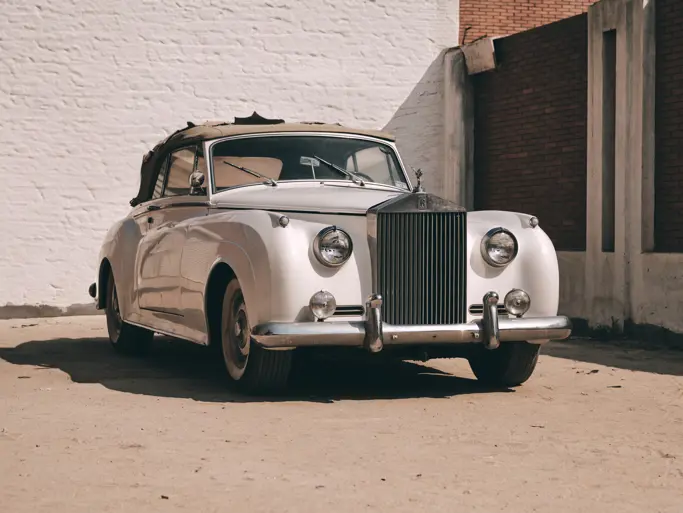Monterey 2017
1959 Aston Martin DB4GT Prototype
{{lr.item.text}}
$6,765,000 USD | Sold
 | Monterey, California
| Monterey, California
{{internetCurrentBid}}
{{internetTimeLeft}}

- ‘Design Project’ for all Aston Martin DB4GTs
- One of the most famous of all Aston Martins and a one-off
- Complete with original delivery engine
- Intimately known to Aston Martin historian and expert Stephen Archer
DESIGN PROJECT 199
It is easy to forget that when Aston Martin announced the DB4 in September 1958, it was the world’s most advanced GT car. Indeed, demand for the new model would vastly outstrip supply. Such was the racing DNA in Aston Martin that, six months before the DB4 was announced, the project to create a lightweight, competition version of the DB4 was sanctioned by John Wyer. That project was DP199.
Once back from the DB4 launch in Paris, the task of designing the DB4GT started in earnest with Harold Beach and Ted Cutting as the designers. John Wyer saw it as a straightforward task and told Ted “to cut five inches out of a DB4 and produce a cheap and cheerful GT car.” Wyer’s dry wit was to the fore, but the design team set about the project with the attention to detail that was typical of Aston Martin’s exceptional engineers. The shortening was behind the front seats, giving it shorter doors and a wheelbase of 93 inches. DP199, the prototype DB4GT, was made by cutting a very early DB4 platform chassis in two with the floor join reinforced by a fishplate, still visible today.
The DB4GT was designed with two seats and a luggage platform in the rear. The doors were lightweight aluminum, and the boot was occupied by a 30-gallon fuel tank with the spare wheel on top, while the entire body skin was in thinner 18-gauge aluminum alloy. The engine was uprated with a twin plug head and triple 45 DCOE Webers. A front oil cooler scoop added to the air intake, and the car ran on Borrani light alloy wheels with uprated Girling brakes. The streamlined body lines had a purposeful, aggressive look in keeping with its intended purpose as a very rapid GT car and gentlemen’s racer.
The DB4GT, with its higher compression ratio of 9:1, featured larger inlet and exhaust valves and uprated camshafts. The twin plug cylinder head was designed specifically for the DB4GT by Ted Cutting, while the transmission was a David Brown four-speed close-ratio synchromesh gearbox, mated to a Borg & Beck nine-inch twin-plate clutch.
DP199 ON THE TRACK
The prototype, DP199/1 (there was never a /2) first ran in March of 1959. It was then taken to Le Mans for the annual test on 26 April 1959 in preparation for the 24-hour race that June. Hubert Patthey drove the car and did a best time of 4 minutes and 38 seconds. This suggests that the car was run at the test with a 3.7-liter engine because the fastest time achieved in practice in June for the race was 4:46 when the car was fitted with a smaller engine.
Appropriately, the first public showing of DP199 – four months before its official launch – was at Silverstone. Stirling Moss and Reg Parnell had asked Wyer to enter the car in a 12-lap GT race at the 2 May International Trophy Meeting. The car had only been back from Le Mans for a few days. Wyer was nervous about racing it at Silverstone so early in its development but need not have been; Moss put the car on pole position, won the race, and set a lap record. His average race speed was 87 mph, and he never used more than 5,500 rpm. In order for the car to be accepted for the race, John Wyer had to sign an undertaking that the prototype would go into production.
Probably due to nervousness of using the untested GT engine at Le Mans and Silverstone, the car ran with a single plug engine, most likely a 3.7-liter DBR2 engine giving a respectable 280 bhp. Aston Martin doubtless avoided using the twin plug version of the DBR2 engine to reduce the chance of a protest from the other teams! Stirling Moss recalled, “All the road-going Astons seemed muscular and strong . . . but the DB4GT was also quite well balanced. It had bags of power and when I drove it against Jaguar saloons, it was no contest.” The Silverstone debut was a publicity triumph.
DP199 was entered at Le Mans in June under the banner of ‘Ecurie Trois Chevrons’ and driven by Aston’s Swiss distributor Hubert Patthey with co-driver Renaud Calderari. For this race the engine was a 3.0-liter, the same type as was used in the DBR3 engine that made a one-off appearance a year earlier. The engine number for Le Mans was RDP 5066-2. The records say that it was RDP 5066-1, but the photographic evidence says otherwise, unless engine 2 was only used in practice. The capacity reduction was achieved with a short stroke crankshaft of 75 mm but a standard bore of 92 mm. This engine is of special relevance to the GT, as it was the first time the twin-plug head was used. It was a dry sump set-up and produced 238 bhp at 6,500 rpm. The oil tank was located in the boot. The front suspension then, as now, was polished forgings as seen on project cars, and it is probable that this was the actual suspension originally seen on the DBR3 for its one-off outing. At Le Mans, the engine ran the number six bearing after just 21 laps.
Following Le Mans, the car was returned to Feltham, where it was converted into what would become road specification and prepared for numerous publicity shots. The single oil cooler scoop was replaced by two smaller scoops that were standard on the first 23 DB4GTs. It was shown at the launch of the DB4GT in London in October 1959. DP199, then registered 845 XMV, entered the second phase of its life as a press car and more significantly as a development car.
In 1960, DP199 was tested at MIRA by Reg Parnell, who was able to go from 0 to 100 mph and back to zero again in 24 seconds. Later he would reduce this to 20 seconds with a taller rear axle. Press reaction after the launch was very positive. Dennis May drove DP199 and wrote in Car and Driver, “It does our English ego good to doubt whether this Englishman’s car is in much danger of having its feat eclipsed by foreign rivals of comparable rating. Or any rating.”
The DB4GT in all its guises had another four years at the top level of international motorsport, and Aston Martin refined the DB4GT into the true thoroughbred that we know today. It also, of course, inspired the underpinnings of the legendary Zagato version and DP214.
Aston Martin would go on to build 75 DB4GTs plus 20 Zagatos. But DP199 was the first and foremost of all the cars. It is the seminal DB4GT and progenitor of all subsequent GT Aston Martins to this day.
STAGGERING ORIGINALITY AND UNPARALLELED IMPORTANCE
DP199 was sold in June 1961 to the Hon Gerald Lascelles, the Queen’s cousin. Gerald had been friend to, and team member of, the Works for a number of years, and his loyalty was doubtless rewarded by the opportunity to acquire this car. Though the first car, it was the 69th DB4GT to be delivered. By this time, development work on the GT had moved onto other areas, including the Project cars; the ‘mule’ for that work would be 0167.
When DP199 was delivered, it was with at least the third engine in its Aston Martin days and was numbered as it is today, 370/0184/GT. Works records show that it was commissioned in July 1959 and was numbered 184. The zero would have been added later; in April 1960, Aston Martin switched all DB4GT engine numbering to four digits being prefixed with a zero – hence 0184. Later in 1961, the DB4GT Zagato ‘0184’ appeared with engine number 0184, but Works records show the two separate engines with different block and head numbers. The original DP199 build card dating from June 1961 has been inspected to support this apparent anomaly. The block in DP199 is the correct, very early type with the side breather mount and the stampings on the block are authentic with the original casting intact.
Lascelles enjoyed the car greatly and kept it at Fort Belvedere. Factory records show that Aston Martin maintained the car until he sold it in 1965 to Mike Salmon, who would have known Lascelles well. Salmon was, of course, a highly noted Aston Martin racer and retained DP199 until 1971. It was then enjoyed by a handful of enthusiasts and notable gentleman drivers of the era such as Chris Stewart, John Norrington, David Preece, Anthony Mayman, and Jimmy Wilson. After being sold to the current owner in 1986, Aston Martin was commissioned to restore the car in 1989.
Under the personal guidance of Kingsley Riding-Felce, DP199 was returned to its Le Mans 1959 guise but kept the 3.7-liter engine. Kingsley recalled: “[the owner] was a great patron and customer and was keen to preserve the car rather than rebuild it. We went to great lengths to retain everything that was original. We even riveted the fish plate back onto the chassis!” The car appeared at the Aston Martin festival at Monterey in 1989 and went on to win its class at Pebble Beach in the same year. Since that time the car has had two other owners, including notable Aston Martin enthusiast Rowan Atkinson, before returning to the current owner, who restored the car in 1989.
DP199 has, in recent years, been greatly enjoyed on road and track, but it has never been subject to any enhancements that would detract from its originality. Remarkably, the car appears never to have had a crash and certainly the bodywork is highly original. In June 2017, the car was inspected and driven by Stephen Archer, noted Aston Martin historian and author of the DB4GT book by Palawan. Stephen commented:
Its restoration in 1989 concerned me because in those less enlightened times, many restorations served to destroy originality rather than respect and conserve it. I need not have worried; the work by Aston Martin in 1989 and subsequent care by R.S. Williams has left us with a car of huge importance that is frankly staggeringly original. To view the unique chassis and compare it to a standard GT is to view a true DP car with nods to the needs of racing and evidence of the sheer genius of the designers at Aston Martin.
To see the original polished wishbones, the Project car style telescopic rear dampers and the unique driver’s wing vent is to take a step back in time. So many details, such as the pedals, the rear parcel shelf design, and the ultra thin lightweight bonnet, all scream ‘designed for the road, built for the track.’ What I found most exciting was to see the original metal around the headlight area and the unique shape of the nose on this car, where it is apparent that they took a DB4 front end and modified the headlight design. It is as if the car left the Works yesterday. I have inspected a lot of Aston Martins, but this one stirs the soul more than most because of its originality, history, and importance in the GT lineage of Aston Martin models.
Stephen then went on to drive the car for some distance on a test track.
To slip into an ex-Moss seat is always special, and the DBR1-style seats add to the sense of occasion. Though on paper this car is not hugely different to a standard GT, the many small differences add up to a very different experience. The engine is clearly in a state of race tune and once ‘on song’ above 2,500 rpm starts to really come to life. The David Brown gearbox can feel notchy in some cars, but in DP199 it is easy, fast, and precise. Brakes are firm and without a servo, the heaviness is compensated by fantastic ‘feel.’ This car feels light, lively, and easy to drive fast, and it is surprisingly quick. It is communicative, tight, and precise. It inspires confidence. It asks to be driven and is hugely rewarding. That it was conceived as a gentleman’s racer 59 years ago is hard to believe. It is a wonderful Aston Martin and without doubt I would suggest the most important DB4GT by some margin.



